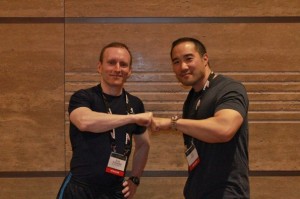
September 4, 2012
Interview with Nutrition Expert Alan Aragon
Those of you who follow this blog undoubtedly know about Alan Aragon. Fact is, there’s no one in the field of nutrition I respect more. Alan holds a master’s degree in nutrition, consults with a legion of famous clients (including Pete Sampras, Derek Fisher, and “Stone Cold” Steve Austin), and serves as the nutritional expert for Men’s Health Magazine. He also edits the excellent newsletter, Alan Aragon’s Research Review, which I previously reviewed here

Most importantly, though, Alan Aragon is the epitome of an evidence-based professional. First and foremost, he is a student of the literature; a veritable walking encyclopedia on nutritional research. Ask him a question about a given nutritional topic and he’ll answer not only by rattling off the results of relevant studies, but also cite the names of the authors and the year of publication as well. It’s quite amazing, actually.
Yet what really sets Alan apart from the pack is his keen understanding as to how research should be applied in practice. He has an astute ability to sift through the body of literature and provide practical recommendations based on a person’s individual needs. His approach is always thoughtful and balanced; a voice of reason. That’s why when I need a get an opinion on a given nutritional topic, Alan’s the guy I turn to for answers. I’ve taught nutrition at the university level. I stay abreast of current dietary research. But Alan is on another level. Call him the “Yoda of nutrition”!
So it goes without saying that I’m pleased to have interviewed Alan for this blog post. Here he shares his knowledge on some of the most controversial and heavily debated topics in nutrition today. As always, Alan is not afraid to speak his mind. Sit back, read, and enjoy!
First, thanks so much for consenting to this interview Alan. For those who might not be aware of your work, can you tell the readers a little about your background.

Thanks for inviting me to unleash hell on your audience, Brad. Anyone who doesn’t know who I am has not done enough trolling through the seedy corners of the internet :)…. In all seriousness though, I’m an educator more than anything else. I have a passion for getting the truth out and seeing learners find their way out of the dark, so to speak. My main vehicle for this is writing, so I guess you could say I’m like Gary Taubes, except I’m not afraid to report the totality of evidence instead of choosing the bits that fit my brand. I used to do fitness training and counseling full-time, but now I maintain a small stable of clients to keep a foot in the trenches while the rest of me is immersed in the research.
You have written about post-exercise protein intake and state that it might not be as important as some claim. But you also discuss that the relative importance is a function of a person’s goals. Can you explain your position?
Let’s first set the stage with some background. Postexercise protein intake has been promoted in both lay and academic circles as an urgent, universally imperative tactic, but it’s rarely ever put in the proper perspective. The origin of the postexercise “anabolic window of opportunity” began with research examining postexercise carbohydrate timing on the rate of glycogen resynthesis after depletion. Delaying carbohydrate intake resulted in significantly less glycogen replenishment, but this finding was limited to an observation period of only a few hours. On a related tangent, subsequent research showed no difference in the amount of post-depletion glycogen replenishment at the 24-hour mark, despite major differences in dietary fat content (originally presumed to impede the process).
Protein got lumped into the supposed ‘magic’ of the postexercise period after studies showed that protein expedited glycogen resynthesis when co-ingested with carbohydrate (particularly in the case of insufficient carbohydrate). Furthermore, research has also shown that protein consumed in the postexercise period can work synergistically with the trained state to stimulate muscle protein synthesis (MPS). However, these studies have two main limitations. First off, in most studies the protein was given to subjects who trained after an overnight fast, minus a pre-exercise meal. Secondly, the bulk of the research showing the benefit of immediate postexercise protein is acute (short-term). The majority of chronic (long-term) studies lasting several weeks has failed to corroborate the acute findings. Many people – even smart folks in the industry – are unaware of this, probably because the bulk of the research with null findings began in 2009 & onward.
This isn’t to say that the body of research on this topic is vast or comprehensive enough to be adamant about the unimportance of protein timing. However, it does provide grounds to assume a wider margin of timing flexibility as long as the total for the day is hit. Hopefully future investigations will compare the timing effects of carbohydrate co-ingested with larger protein doses that max-out acute MPS in trained subjects on diets that provide sufficient total protein that’s matched (including supplemental protein) between groups. Thus far, the research in this vein is scarce, but would help provide an important puzzle piece. In the mean time, hitting the total protein target for the day remains the primary objective, while timing and distribution of its constituent doses is the distantly secondary concern. At best, specific timing is the icing on the cake. But, you have to have the cake down-pat, otherwise the icing means crap.

Any benefit to consuming one type of protein over another (i.e. whey vs. casein)?
In the larger picture, the answer for the most part is no. Assuming that someone is consuming sufficient total daily protein from a variety of high-quality sources, then their bases will be covered, regardless of differences in protein type. Short-term data indicates the superior effects of whey (compared to casein or soy) on MPS at both the resting & postexercise periods. It’s been speculated that this is due to the greater overall rise in circulating amino acid (particularly leucine) levels yielded by whey. However, studies that dragged this type of comparison out for several weeks have shown equivocal outcomes. Whey, as opposed to casein or soy, has not emerged as the dominant winner for improving muscular adaptations to training. This serves to reinforce the principles that a) total daily amount of high-quality protein is of prime importance, b) differences seen shortly postexercise will not automatically translate to long-term adaptations, and c) the body of evidence is subject to evolve.
How important is macronutrient ratio with respect to weight loss?
People have varying total energy demands, and this can differently influence their macronutrient requirements. Ratios per se shouldn’t be the focus since they’re merely a default result of figuring absolute needs. For example, those with a moderate to high energy output (through formal training, non-exercise activity, or both), can typically consume a higher amount of carbohydrate and still lose weight. In contrast, sedentary or barely active folks have lower overall energy demands, thus a high carbohydrate intake wouldn’t likely be optimal. Nevertheless, there’s rather interesting, yet unreplicated research examining the effects of insulin sensitivity on weight loss (low-carb worked better for insulin-resistant subjects while high-carb worked better for insulin-sensitive subjects). Unfortunately, body composition wasn’t assessed, nor was there any structured exercise protocol. My hunch is that a well-designed, progressive training program would greatly diminish the influence of pre-existent differences in insulin sensitivity on weight loss.
Are you a proponent of cutting carbs for someone who wants to get really lean?
For losing fat past the initial stages, I’m a proponent of imposing a calorie deficit, and depending on the individual situation, this can involve a decrease in caloric intake, an increase in caloric output, or a combination of both. In the case of intake reduction, it doesn’t make sense to hack into critical nutrients – especially protein, whose requirement actually increases in a caloric deficit. So, for the most part, it’s carbs that will get the brunt of the reduction when it’s time to cut calories, while protein & fat remain somewhat stable (I typically set protein slightly higher than it needs to be). The degree of carb reduction varies individually, but the underlying aim is to consume the highest amount of carbs that still allow a satisfactory rate of fat loss. This approach accomplishes two main things – it enables the highest possible training performance (in terms of both strength & endurance), and also the lowest chance of undue hormonal downregulation from prolonged bouts of dieting. Carb reduction can then be strategically positioned as a trump card. In other words, carbs can always be incrementally reduced on an as-needed basis, depending on how results are proceeding. Starting off with minimal carbs from the get-go leaves fewer options in the toolbox to break through progress plateaus once training volume is maxed-out.
Intermittent fasting has gained popularity recently. What are your thoughts? Panacea or fad?
I think the popularity of intermittent fasting (IF) is, for the most part, a good vindication of science. Academics have known for a while now that research has not supported the lore of frequent, small meals to stoke the metabolism better than the equivalent in larger, fewer meals. Furthermore, research has not supported the idea that small, frequent meals are necessary for preserving muscle mass. The evidence as a whole has not indicated any threat to muscle preservation during dieting when meal frequency is reduced – either daily or intermittently through the week. In fact, some studies have shown superior lean mass retention with IF during hypocaloric conditions. However, this could have been due to measurement error inherent with bioelectrical impedance analysis. It should also be noted that the IF research thus far has not involved structured exercise protocols.
At the same time that IF has vindicated science, it also created its own over-zealous following who preaches its universal necessity for optimizing body composition and health. Viewed more objectively, IF presents an effective option for those who prefer the convenience and luxury of larger meals – not to mention, less preparation & transportation of meals through the day. Any special or superior metabolic effects of IF compared to conventional meal patterns are speculative at this point. While IF has consistently shined in the department of lean mass retention while dieting, its comparison to conventional meal frequency on gains in muscular strength & hypertrophy is uncharted ground, at least in formal research. There are plenty of hypotheses flying around this area, but nothing demonstrated under controlled conditions. For the time being, meal frequency for optimal size & strength gain remains mysterious. This mystery is likely to begin unfolding with short-term data that one camp will excitedly embrace. If history means anything, the acute data will be followed by long-term data that shakes the confidence in former beliefs. Either way it goes, I’ve got my popcorn ready.
On a final note, I’ve seen the greatest client success come from letting individual preference dictate meal frequency. Some people do great on small frequent meals, others do great on the opposite (and all points in between). The theoretical advantages of any given dietary approach go straight out the window if it’s at odds with someone’s personal preference & adherence capability.
Tell us a little about your research review and how you came to start the service.
In a nutshell, my research review (AARR) is a monthly romp through the current and past research on nutrition, training, and supplementation. I do my best to present both the theory and application of the concepts and findings. The idea to start AARR was born from my own dissatisfaction with my knowledge level despite having vast client experience, multiple training certifications, a graduate degree in nutrition, and being active in attending & presenting continuing education lectures. I felt like there had to be some way to further “force” myself toward the top tier of expertise. Putting AARR together each month was the logical solution for my self-directed learning tendencies. I’m now enjoying the process of sharing my ongoing enlightenment with like-minded folks inside and outside of the field.
Great stuff, Alan. Really appreciate you taking the time to share your views!
Check out Alan’s blog Here
Check out Alan’s excellent research review (AARR) Here
18 Comments
RSS feed for comments on this post.
Sorry, the comment form is closed at this time.





 Entries (RSS)
Entries (RSS)




Great interview!
Comment by Daniel — September 4, 2012 @ 2:47 pm
Great interview.
Those are some of the questions I get asked regularly, so it’s nice to have a place to link to when I’m lazy.
Thank you both.
Roland
Comment by Roland Denzel — September 4, 2012 @ 7:45 pm
Good to see applied science chipping away at nutrient timing mythology.
Comment by David Barr — September 4, 2012 @ 8:32 pm
[…] […]
Pingback by Interview with Nutrition Expert Alan Aragon....by Brad Schoenfeld - World Class Bodybuilding Forum — September 5, 2012 @ 3:26 pm
Great, if short, interview. Aragon, like Colpo, has a great way of concisely telling us all what is what. The devil is always in the details and most people simply do not have the time or know-how to sort through the abstracts and headlines to find out the reality.
Comment by ben — September 7, 2012 @ 9:53 am
[…] […]
Pingback by [Article] Interview with Alan Aragon - Ausbb - Australian BodyBuilding — September 8, 2012 @ 7:28 pm
More Aragon worshipping at its finest! Dieting fags in forums always worship this guy.
Comment by Aragonworshipper — September 10, 2012 @ 12:32 am
[…] Grip Tips – Wil Fleming 4 Reasons You’re Not Gaining Muscle – Brad Schoenfled Interview with Alan Aragon – Brad Schoenfled Advice from Dad – Amy Wattles Eff-It Part 1 – Molly Galbraith Eff-It Part 2 – […]
Pingback by Top Good Reads of the Week: Edition 14 | LaVack Fitness — September 12, 2012 @ 8:33 pm
[…] buddy Brad recently interviewed my buddy Alan HERE. If you don’t follow Alan then you should […]
Pingback by Bret Contreras » Random Thoughts — September 15, 2012 @ 4:47 pm
“On a final note, I’ve seen the greatest client success come from letting individual preference dictate meal frequency. Some people do great on small frequent meals, others do great on the opposite (and all points in between). The theoretical advantages of any given dietary approach go straight out the window if it’s at odds with someone’s personal preference & adherence capability. ”
^ Quite sensible!
Comment by Mitch — September 19, 2012 @ 11:00 am
[…] UPDATE: Check out my latest interview I did with Brad Schoenfeld, talking about a bunch of interesting topics here. […]
Pingback by The 2012 NSCA Personal Trainer’s Conference: Vegas, Baby! | Alan Aragon's Blog — September 26, 2012 @ 1:10 pm
[…] As for the second part of the question, many people have inspired me, but my most recent inspiration has been Brad Schoenfeld, an exercise scientist who has all of the aforementioned qualities in abundance. Note: anyone who missed my interview with Brad can read it here. […]
Pingback by On Leadership | Alan Aragon's Blog — January 11, 2013 @ 6:53 pm
I’ve read a huge amount of the published articles and research on nutrient timing. It is true that much more research needs to be done before we fully understand it’s resu;lts, but it sounds to me like you are just going against the current findings just to be different, or maybe stand out to get noticed. There is definately room to go both directions right now, so I think it is important to stay neutral until enough research results are published. It is always best to be patient and cautious with scientific findings as prior history has taught us.
Comment by Mike Lawson — February 18, 2013 @ 7:42 pm
Mike:
Alan and I recently published an extensive review on the topic in the Journal of the International Society of Sports Nutrition. You can read the article at the link below.
http://www.jissn.com/content/pdf/1550-2783-10-5.pdf
Brad
Comment by Brad — February 21, 2013 @ 10:24 pm
Great interview. All of this information resonates with me really well. When I first started dieting and working out I followed the small frequent meal idea religiously. After a while I got tired of it and started reading things that said it wasn’t necessary. Now I feel that it’s much more important to get all of the nutrients in on a daily basis without regards how many meals it takes.
Comment by Jake Long — January 7, 2014 @ 11:27 pm
Very insightful interview. I didn’t know that there is a debate about the positive effects of having multiple, small meals instead of a few large ones. I thought this is an universally supported idea. Thank you for opening my eyes.
Comment by Dave — May 15, 2014 @ 5:37 am
[…] Imagine the protein shake after a workout as “icing on the cake”. As I mentioned in my pyramid description for Organic Food, you need a strong base. That base is the layers of the actual cake. Alan Aragon, one of the world’s top nutrition experts and evidence-based researchers, is quoted stating, “At best, specific timing is the icing on the cake. But, you have to have the cake down-pat, otherwise the icing means crap” (Source). […]
Pingback by When you Should Actually Get your Protein - Train Heroic — June 24, 2014 @ 12:08 pm
[…] When it comes to nutrition there is no one in field of nutrition that I have more respect for and no one that I have learned more from than Alan Aragon. Brad Schoenfeld, described Alan best when he wrote in this article: […]
Pingback by An Interview with Alan Aragon: Nutrition Expert, Researcher, and Writer | FitPossibilities — March 15, 2015 @ 6:25 pm